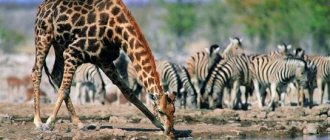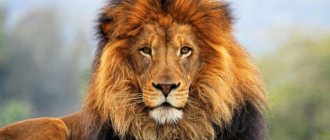Young children often baffle their parents with their unusual questions. How much does an elephant or whale weigh? Who is stronger - a rhinoceros or a lion? How do giraffes sleep? Most often, adults themselves do not know the answer to them, because they have conveniently forgotten the school curriculum, and in adult life such information can be useful to few people. But a child’s inquisitive mind is just learning the picture of the world; it absorbs new knowledge like a sponge. Little researchers are interested in literally everything, even things that would never occur to an adult. This article is dedicated to one of the popular children's burning questions, namely: “How do giraffes sleep?” At the same time, we will look at other interesting facts related to these graceful animals.
In what position does a giraffe sleep?
In the fifties of the last century, at the Frankfurt Zoo, scientists conducted research on the conditions and duration of sleep of various pets: elephants, lions and others. When the turn came to the tallest animals in the world, very stunning facts were discovered. About an hour after the zoo closed, with the onset of evening twilight, when the last employees left the pavilion, these animals, after a whole day of standing and walking, sank to the floor. First, the giraffes tucked their front legs and one back leg under their stomach, and extended the other hind leg to the side. They changed them periodically throughout the night. At the same time, the animal’s neck remained in a vertical position. The giraffes either lay quietly or chewed cud. Sometimes they froze, from time to time they moved their ears, the eyelids very slowly dropped over their eyes, but after a few minutes they opened again. When it became completely dark, the animals bent their necks backwards from the side, with the giraffe’s nose touching the floor near the ankle of its hind leg, and the lower jaw ending up near the lower leg. The head alternately fell on the left and then on the right legs. Scientists were amazed at how such a huge and seemingly awkward animal could curl up into a ball as deftly as an experienced yogi. Their cubs laid down in exactly the same way. For those who are interested in how giraffes sleep, the photo below will demonstrate this process in full. Now consider the following interesting fact related to these representatives of the animal world.
Description of the giraffe: appearance, physiological characteristics
The giraffe is a cloven-hoofed herbivore mammal, the tallest creature on land. The habitat of these beautiful animals covers the savannahs of Africa.
A giraffe can be 6 meters tall: about one third of it is its neck. The average weight of a male is 1000 kg, females are smaller and lighter. The neck has the same characteristics as those of a standard mammal. The giraffe boasts long, strong legs and large eyes. The back is flat, the tail is elongated and narrow, with a tassel.
Giraffes have a spotted color that changes depending on their living conditions and health status. These animals have different patterns that remain the same throughout their lives.
Giraffes see, hear and smell very well. This gives them the opportunity to be always alert and avoid danger in time.
How long do giraffes sleep?
Children usually do not ask such a question, however, since we have already begun to understand these spotted giants, then for the sake of general development we can learn this fact. Now, by telling your child how giraffes sleep, you can also educate him about the duration of this process. It turns out that these animals cannot sleep for long periods of time. Their usual state at night is half-asleep. Scientists could not determine exactly how long it lasts, since they were unable to record the beginning and end of the process. Giraffes have never slept all night long. Approximately every two or three hours, first one or another animal rose to its feet. They walked around, relieved themselves, and fed themselves. The young stood up more often than the adults. However, researchers were able to establish that from time to time these creatures are capable of falling into a full-fledged deep sleep. It lasts only from one to twelve minutes. At dawn, the animals are on their feet again, so as not to lie down until dusk. We looked at how much a giraffe sleeps per day, how it does it, and now we will get acquainted with other features and facts related to these curious artiodactyls.
Life expectancy of giraffes
How many years does a giraffe live? Of course, such a large animal should live a very long time, but the average age is 20-23 years. The maximum age a giraffe lived was 28 years. The cub is with its mother from the moment of birth until 1.5 years of age. At 4 years old it becomes sexually mature.
In captivity, life expectancy increases and can reach about 30-35 years.
Total information
The pattern on the giraffe's body consists of an abundance of dark spots that stand out against the lighter base color. This ornament is individual for each individual, like human fingerprints. On the giraffe's head there is a pair of fur-covered horns, thickened at the ends. Sometimes there are animals with two pairs. There is often a peculiar ossified growth in the middle of the forehead, which is often mistaken for another horn. The giraffe's ears are short, its eyes are fringed with long thick eyelashes. These mammals have excellent hearing, vision and sense of smell, which, along with their high growth, allows them to notice danger in time. A giraffe can see its relatives even at a distance of more than one kilometer.
How do dinosaurs sleep?
Scientists: Dinosaurs slept the same way as humans and other mammals Observations of sleeping lizards helped scientists prove that dinosaurs and all other reptiles slept and sleep in the same way as we do, alternating between stages of REM and slow-wave sleep, which indicates an extremely ancient nature this trait of our organisms.
Interesting materials:
What is the length of the freight car? What is the length of the semi-trailer? What should be the consistency of glue for non-woven wallpaper? What should be the correct Turk? What is the first economy in the world? What was Catherine 2's last name? What is the last name of Yakubovich's daughter? What is Elina Fox's last name? What is the leaf shape of alder? What is the form of government in Britain?
Parametric data
An adult (male) reaches a height of six meters, and weighs slightly less than a ton. Newborn cubs weigh one hundred kilograms and reach a height of one and a half meters. Within an hour after giving birth, the giraffe gets to its feet. The heart of the tallest land animal also has significant parameters. Its weight is 11-12 kilograms, its length can reach 60 centimeters, and its wall can be six centimeters. The giraffe's tongue is also striking in its size. Its length can reach up to 45 cm. He can even clean his ears with it! These animals consume up to 30 kg of food daily. They spend 16 to 20 hours a day doing this activity. As you can see, for developing children (as well as for adults), not only the question of how giraffes sleep, but also other, no less interesting facts can be interesting.
Giraffe height and weight
The height of a giraffe on average ranges from 5 to 6 meters, with the neck taking up 30% of it. Weight ranges from 500-1900 kg. It depends on what species the animal belongs to. The appearance of a giraffe creates the impression of an elegant and graceful representative of the fauna. Therefore, it is very difficult to imagine that some individuals can weigh almost 2 tons.
The giraffe is by far the tallest of all living mammals. Scientists say they can reach 7 meters. But the officially recorded tallest giraffe lived at Chester Zoo in England. His height was 6 m.
The animal's heart weighs about 12 kg. This allows you to distill 60 liters of blood per minute.
At birth, the giraffe is about 150 cm tall and weighs 100 kg. An hour after birth, he is already fully on his feet.
And only the wind whistles
With its enormous size and decent weight, the giraffe turns out to run very deftly. In case of urgent need, he can gallop, reaching speeds of up to 55 km/h. Essentially, he outpaces a racehorse over a short distance. In a calm state, these spotted giants walk slowly, moving alternately the right and then the left pairs of legs. The length of such a step is approximately eight meters. Moreover, giraffes can not only run, but also jump. These, at first glance, clumsy and bulky creatures are capable of overcoming barriers up to two meters high.
Who sleeps upside down
Let's start with what sleep is as such. During sleep, there is usually a decrease in physical activity and a weakening of reactions to external stimuli. Sleeping creatures often choose the most comfortable sleeping position - humans, cats and many others lie horizontally, bats hang upside down, and elephants and horses stand on their feet. In addition, it is very easy to “fall out” of sleep (as everyone who has to get up in the morning with an alarm clock knows about). This distinguishes it from other states of the so-called “off consciousness” - hibernation or coma.
What do giraffes eat?
These African giants are exclusively herbivores. Their physiology and body structure allow them to feed on leaves from tree crowns - in this matter they have no equal, they will get food at such a height that others cannot reach in life! Of all the variety of woody vegetation, giraffes prefer acacia. The animal wraps its long tongue around the branch, then pulls it towards its mouth and plucks the leaves, pulling back its head. The lips and tongue are designed in such a way that they are not damaged even by thorny branches. Basically, giraffes' fluid needs are met by food. As a result, these artiodactyls can go without water for several weeks, i.e. much longer than camels. However, if they do find life-giving moisture, they can drink almost 40 liters of liquid at a time.
Population and species status
Giraffes are rightfully considered the personification of calm and the calling card of Africa; they get along well with people and are quite peaceful. Even in ancient times, the aborigines had difficulty hunting these giants of the world fauna, so they were never the main prey. But having killed this animal, they tried to use every part of it to the maximum. The meat was eaten, the sinews served as excellent strings and strings for bows, the skins were shields or material for clothing, the hair was used as tassels for creativity, the tail could serve as decorations for the home or as bracelets.
There used to be a lot of giraffes; they inhabited almost all continents of Africa before the advent of colonialists. These people brought destruction to many places and exterminated many animals, and the tallest mammals were no exception. They were killed for the sake of skins and leather, which were sold or used for belts, whips were woven from it, carts were strengthened and many other items that people thought were necessary.
Subsequently, hunting turned into full-fledged poaching and barbarism; settlers from Europe began to brutally kill animals not even for the purpose of profit, but simply for their own pleasure. They felt a thirst for blood and adrenaline rushed into their heads, because they were able to kill giants, whom even lions were afraid of. They were killed in tens and hundreds, driven into safari, and the tails of the corpses were cut off as a trophy, leaving the rest of the body to rot.
The result of such atrocities on the part of people was a reduction in the giraffe population several times. Now they are practically not hunted, because even wild habitats are under strict state protection, but the number continues to decrease every year due to another problem - deforestation and destruction of habitats familiar to these animals.
At the moment, there are only two genera in the Giraffidae family: the giants themselves and modern small artiodactyls called okapi or Johnston's okapi. In terms of their physique, they do not stand out in size, so they are more like horses with the head of a giraffe and stripes on their legs, like a zebra. These relatives live in the Democratic Republic of the Congo, outside of which they are not found. The number is unknown, but according to rough estimates it ranges from 30-35 to 50 thousand. There are no more than two hundred of them in zoos around the world.
Do you know?..
Now we’ll tell you something more interesting about giraffes. These inhabitants of the African savannas got their name from the Arabic word “zarafa”, which means “elegant”. By the way, this is the only animal in the world that is born with horns. There is a common belief among most people that giraffes are voiceless creatures. However, this is not at all true. It turns out that they communicate perfectly with each other, it’s just that the sounds they make are at frequencies below 20 Hz. And as you know, this range is inaccessible to human hearing. The way giraffes give birth to babies is also interesting. The fact is that this process occurs in a standing position, as a result the cub falls to the ground from a height of two meters. And finally, here’s another interesting fact: it turns out that the neck of this animal contains only seven vertebrae - the same number as a human. Interesting, isn't it?
Giraffe habitat
Giraffes live in the wild in Africa. This is the only continent where they can be found in their natural habitat. Herds of giraffes or individual individuals are found in the southern and southeastern regions of the Sahara Desert. In addition, they began to live in even more arid areas of African land where people do not live. Thanks to their bodies and low water consumption, these mammals exist comfortably in the open forests of Africa.
Previously, long-necked animals were subject to total hunting, so they had to change their usual habitats. Today they are found in places where they were not previously found.
Sleeping or pretending
As for invertebrates and other simpler forms of life, they are rarely studied using electroencephalograms. Therefore, for them, the concept of “sleep” is synonymous with “physical inactivity,” when, with a certain cyclicity, they take typical poses and then return to activity. In the case of fish and amphibians, it is still unclear whether they actually sleep or simply display signs that indicate a state of rest. But insects, for example, prefer to sleep.
Your comment on the question:
| Display name (optional): |
| Write to me if a comment is added after me: Write to me if a comment is added after me |
| Privacy: Your email address will only be used to send notifications. |
| Anti-spam check: |
| To avoid future audits, please sign in or register . |
Bedtime rituals
A person falls asleep best in a familiar environment and in a favorite position. Animals are no different from him in this sense. Dogs and cats often circle in place, getting comfortable. Hamsters and rats are thoroughly cleaned.
The chimpanzee builds a new nest in a tree every time, and while the children are small, he allows them to spend the night with him. As soon as the kids grow up, they learn to build their own shelter. However, at first there are problems with construction, so little chimpanzees often come to their mother’s “bed,” just like children.
Snowshoe hares rest during the day. In secluded places they choose a platform and diligently compact the surface on it. In summer - grass, in winter, in frosty weather, - they dig holes, carefully compacting the snow.
Some species of brightly colored parrotfish appear to be wearing a “nightgown.” They secrete mucus through their mouth, which envelops the body like a cocoon. The cocoon serves as protection against parasites and maintains electrolyte balance. When waking up, the fish “takes off its pajamas.”











